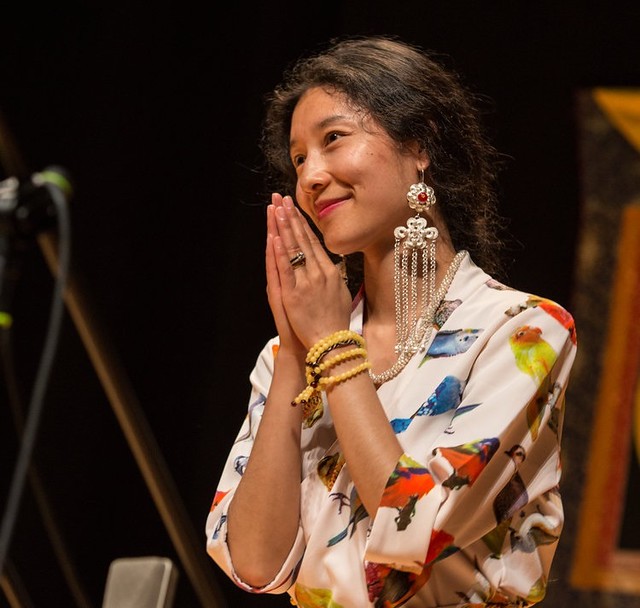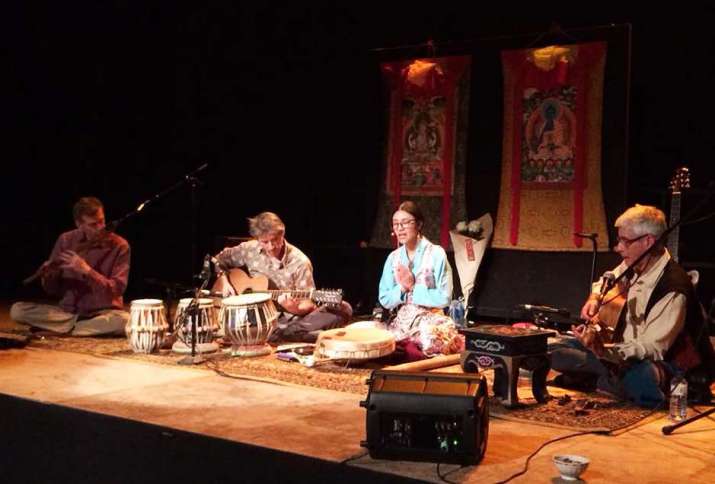In the Buddhist tradition, dakinis are worshiped as female emanations of wisdom that hold the key to the esoteric knowledge of Vajrayana Buddhism and reveal the path to complete freedom. They inspire and assist practitioners on the spiritual path and manifest in different forms beyond time and space. In Tibetan they are referred to as khandroma, which means “she who walks in space,” referring to the fundamental wisdom of emptiness, which is considered a female principle.
In our contemporary world, we meet remarkable Buddhist women, in both the East and the West, who are perceived to embody dakini and who have the freedom to practice and teach the Dharma, and to express their spiritual experience in different ways. These are powerful women who spread the Dharma through teaching, writing, singing, painting, or dancing, and some of them are officially recognized as an embodiment of a dakini.
I recently met a lovely dakini on the Internet and was inspired by her youthful beauty, compassionate heart, profound wisdom, clear mind, and gentle voice, spreading healing energy. Known by the name Drukmo Gyal Dakini, she travels the world spreading Dharma by giving teachings and by singing healing mantras.

Drukmo Gyal means “victorious female dragon” in Tibetan, a name given to her by an old yogi who was a friend of her grandfather. She was born in 1989, in the village of Tongso, close to Rebgong County in the traditional Amdo region of northeastern Tibet, now known as Huangnan Tibetan Autonomous Prefecture in China’s Qinghai Province.
Drukmo Gyal comes from a family of Tibetan yogi, who introduced to her the Buddhist practices of mantra, yoga, and meditation at a young age. After practicing the ancient melodies of various mantras with the local Tibetan yogic community, she started singing publicly in 2008. Moving to Europe in 2013, she produced her first album, Purification Voice of Tibet, in 2015, and a second, Tibetan Mantra Healing, in 2016. Drukmo Gyal travels throughout Europe, Russia, Malaysia, and China to spread the ancient Tibetan healing practices through singing, teaching, and leading retreats.
Drukmo Gyal Dakini recently sat down with Buddhistdoor Global and shared her experiences on the Buddhist path and her thoughts and impressions of dakini nature.
Buddhistdoor Global: Can you describe the life of a Tibetan yogi family?
Drukmo Gyal Dakini: The lifestyle of a Tibetan yogi family is pretty normal. We begin the morning by making offerings to visible and invisible beings with fire smoke and morning prayers. Each person has their own prayers. Then we have some practices that we perform together on auspicious days when we go to the mani houses, the yogi temples. At other times, we do our individual practices according to our own schedules. Some yogis and yoginis have jobs to do. They might be taxi drivers, farmers, lawyers, teachers, they do their work and then by the end of the day they have evening prayers. Each year, they look for an opportunity to visit their teachers and seek time to undertake retreats, either for a shorter or a longer period—depending on personal time constraints and their family circumstances.
BDG: Which school of Tibetan Buddhism do you follow and who is your main guru?
DGD: I follow the schools of my family. My mother’s side is Nyingma and my father’s side is Gelug. I have more experience in the Nyingma tradition of my my mother’s side, so I mainly follow the Nyingma tradition. My first guru is my grandfather. Later on I met my root guru Dr. Nida Chenagtsang, the founder of Sorig Khang International and a wonderful Tibetan physician.

BDG: Why did you come to Europe and where are you living currently?
DGD: I came to Europe at the end of 2013 with the aim of learning Spanish. I went to Spain for a year to study and I worked part-time for Sorig Khang Valencia. That was my starting point working for Sorig Khang International, the largest academy for traditional Tibetan medicine. At the moment, I live in Talinn, the capital of Estonia, and I work for Sorig Khang Estonia, of which I am a board member.

BDG: How do you see the growth of Buddhism in Europe?
DGD: Generally in Europe I see that people’s need for spirituality is increasing dramatically, but the way they accept spirituality is very materialistic. In reality, you cannot divide the two. You have to somehow combine spirituality and materialism in order to spread Buddhism, which sometimes confuses people. Most importantly, however, is that we have good motivation in whatever we are doing. If we have this mindset, I believe that the advantages always ooutweigh the disadvantages. As long as we have the awareness of holding compassion close, as much as we can, we are always able to avoid misunderstandings like harm to others and to ourselves.
BDG: How have European people responded to your music and teachings?
DGD: I find that 80 per cent of the people who come to the concerts and the teachings are women. Their feedback to me and to the organizers of my concerts and teachings has been very positive. They find it very helpful, healing, and more. I was actually not expectating this—it is a mutual healing process. Not only are my audiences experiencing the healing benefits, but so are the organizers, including myself, and the people who are otherwise involved in these activities. So I think it’s a beautiful way to be connected.
BDG: Do you feel you are a dakini and what is a dakini for you?
DGD: Actually Drukmo Gyal is my name and Dakini is the name of my project. I hope that through this project we can help people find their dakini nature. Dakini was also the name that my root guru, Dr. Nida Chenagtsang, gave me as my “art name.” When I was in Spain, everybody called me Dakini, but it was just a name and not to identify me as a khandroma.
I believe a dakini is an embodiment of female energy. It is a beautiful, divine way of seeing female energy. And I do believe that everyone has dakini quality. I don’t personally see anybody being a dakini all the time, but I do see moments of dakini emenation in everyone I’ve met. I see their moments of being a dakini and I believe that those little moments can be stretched once their wisdom and compassion increases. Recognation of dakinis is important, but the growth of wisdom and compassion is more worth our attention.
See more












